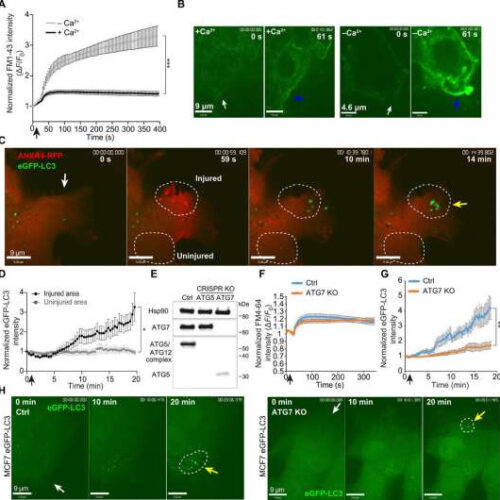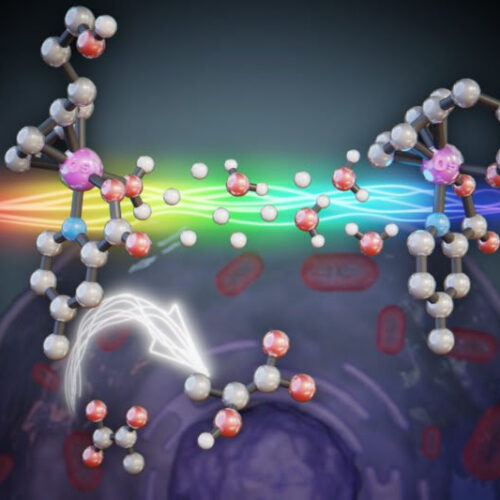by Tohoku University Perfusion defect in the lymph node visualized by contrast-enhanced micro-computed tomography and high-frequency ultrasound (arrows). Credit: Tohoku University If not caught quickly, cancer cells often spread to other organs in a process called metastasis. Lymph nodes (LNs) are the organs with the highest risk of metastasis. Metastasis in the LNs also influences...
Tag: <span>cancer cells</span>
Wounded cancer cells supercharge immune system to destroy tumors
By Nick Lavars October 20, 2021 Scientists have discovered a new way to enhance the ability of T cells to fight tumorsMIT/iStockphoto Scientists at MIT have made a discovery that could expand the potential of immunotherapy, enabling it to treat wider variety of cancers. The breakthrough stems from a newfound ability to jump-start the body’s...
One cell in 10,000
Cancer cells aren’t good citizens—they’re selfish and lazy, loitering around in clusters, stealing resources from neighboring cells, and refusing to contribute to the good of the community. But the vast majority aren’t murderers. Out of every 10,000 cells that make up a tumor, 9,999 are basically innocent. Deadbeats, sure, but not criminals. That one, though? It’s...
A peptide-drug conjugate that targets the acidic environment of cancer cells may improve the efficacy of immunotherapy
AMERICAN ASSOCIATION FOR CANCER RESEARCH PHILADELPHIA – A peptide-drug conjugate that targets the acidic environment of cancer cells enhanced the efficacy of immune checkpoint inhibitors in preclinical cancer models, according to results presented at the AACR-NCI-EORTC Virtual International Conference on Molecular Targets and Cancer Therapeutics, held October 7-10, 2021. Immune checkpoint inhibitors are commonly combined with...
Scientists provide new insight on how to stop transcription of cancer cells
by University of California, Los Angeles Credit: CC0 Public Domain Scientists from the UCLA Jonsson Comprehensive Cancer Center have identified a key protein, transcription factor TAF12, that plays a critical role in the formation of a preinitiation complex, which consists of over one hundred proteins that are necessary for the transcription of protein-coding genes. The team...
A noninvasive test to detect cancer cells and pinpoint their location
MASSACHUSETTS INSTITUTE OF TECHNOLOGY CAMBRIDGE, MA — Most of the tests that doctors use to diagnose cancer — such as mammography, colonoscopy, and CT scans — are based on imaging. More recently, researchers have also developed molecular diagnostics that can detect specific cancer-associated molecules that circulate in bodily fluids like blood or urine. MIT engineers...
Cancer cells eat themselves to survive
by Jesper Nylandsted, University of Copenhagen Fig. 1 Laser injury leads to ATG7-dependent formation of LC3-positive vesicles around the plasma membrane repair area. (A) MCF7 cells were injured by ablation laser in a medium with or without Ca2+. Mean ± SEM of normalized FM1-43 cytoplasmic dye levels, 11 cells per condition from three experiments, P <...
Osmium activation in cancer cells
Cancer is a complex disease, and as such, there is not just a single way to tackle it. While cancer treatments are evolving towards personalized procedures, in most cases standard chemotherapy treatments are still required. In chemotherapy, platinum drugs such as cisplatin (approved 42 years ago by FDA) are used, killing both cancerous and healthy...
Microfilter device capable of detecting trace amounts of cancer cells in one mL of blood
KUMAMOTO UNIVERSITY IMAGE: Top: The device is small enough to fit in the palm of your hand. Bottom left: The device filter is designed with slits allowing for deformation with fluid force. Bottom right: As blood flows through the device, the fluid force causes the slits to open, changing the shape of the filter and...
How a protein named STING assaults viruses and cancer cells that invade us
by Delthia Ricks , Medical Xpress Electron micrographs of hepatitis C virus purified from cell culture. The scale bar is 50 nanometers. Credit: Center for the Study of Hepatitis C, The Rockefeller University. The molecular world is full of surprises, and none more stunning than those occurring among the infinitesimal proteins that drive the activities...








